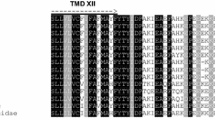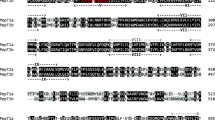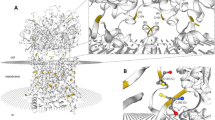Abstract
Amino acids play an important role in the metabolism of all organisms. Their epithelial re-absorption is due to specific transport proteins, such as B0AT1, a Na+-coupled neutral amino acid symporter belonging to the solute carrier 6 family. Here, a recently cloned fish orthologue, from the intestine of Salmo salar, was electrophysiologically characterized with the two-electrode voltage clamp technique, in Xenopus laevis oocytes heterologously expressing the transporter. Substrate specificity, apparent affinities and the ionic dependence of the transport mechanism were determined in the presence of specific collectrin. Results demonstrated that like the human, but differently from sea bass (Dicentrarchus labrax) orthologue, salmon B0AT1 needs to be associated with partner proteins to be correctly expressed at the oocyte plasma membrane. Cloning of sea bass collectrin and comparison of membrane expression and functionality of the B0AT1 orthologue transporters allowed a deeper investigation on the role of their interactions. The parameters acquired by electrophysiological and immunolocalization experiments in the mammalian and fish transporters contributed to highlight the dynamic of relations and impacts on transport function of the ancillary proteins. The comparative characterization of the physiological parameters of amino acid transporters with auxiliary proteins can help the comprehension of the regulatory mechanism of essential nutrient absorption.







Similar content being viewed by others
References
Bohmer C, Broer A, Munzinger M, Kowalczuk S, Rasko JE, Lang F, Broer S (2005) Characterization of mouse amino acid transporter B0AT1 (slc6a19). Biochem J 389:745–751
Bossi E, Centinaio E, Castagna M, Giovannardi S, Vincenti S, Sacchi VF, Peres A (1999) Ion binding and permeation through the lepidopteran amino acid transporter KAAT1 expressed in Xenopus oocytes. J Physiol-London 515:729–742. doi:10.1111/j.1469-7793.1999.729ab.x
Bossi E, Sacchi VF, Peres A (1999) Ionic selectivity of the coupled and uncoupled currents carried by the amino acid transporter KAAT1. Pflugers Arch 438:788–796
Bossi E, Fabbrini MS, Ceriotti A (2007) Exogenous protein expression in Xenopus Laevis oocyte, basic procedure. In: Grandi G (ed) In vitro transcription and translation protocols, 375th edn. Humana Press, City, pp 107–131
Bossi E, Renna MD, Sangaletti R, D'Antoni F, Cherubino F, Kottra G, Peres A (2011) Residues R282 and D341 act as electrostatic gates in the proton-dependent oligopeptide transporter PepT1. J Physiol 589:495–510
Bossi E, Cherubino F, Margheritis E, Oyadeyi AS, Vollero A, Peres A (2012) Temperature effects on the kinetic properties of the rabbit intestinal oligopeptide cotransporter PepT1. Pflugers Arch 464:183–191
Broer A, Klingel K, Kowalczuk S, Rasko JE, Cavanaugh J, Broer S (2004) Molecular cloning of mouse amino acid transport system B0, a neutral amino acid transporter related to Hartnup disorder. J BiolChem 279:24467–24476
Broer A, Cavanaugh JA, Rasko JE, Broer S (2006) The molecular basis of neutral aminoacidurias. Arch Eur J Physiol 451:511–517. doi:10.1007/s00424-005-1481-8
Camargo SM, Makrides V, Virkki LV, Forster IC, Verrey F (2005) Steady-state kinetic characterization of the mouse B(0)AT1 sodium-dependent neutral amino acid transporter. Pflugers Arch 451:338–348
Camargo SM, Singer D, Makrides V, Huggel K, Pos KM, Wagner CA, Kuba K, Danilczyk U, Skovby F, Kleta Ret al (2008) Tissue-specific amino acid transporter partners ACE2 and collectrin differentially interact with Hartnup mutations. Gastroenterology
Cheon CK, Lee BH, Ko JM, Kim HJ, Yoo HW (2010) Novel mutation in SLC6A19 causing late-onset seizures in Hartnup disorder. Pediatr Neurol 42:369–371. doi:10.1016/j.pediatrneurol.2010.01.009
Daniel H, Kottra G (2004) The proton oligopeptide cotransporter family SLC15 in physiology and pharmacology. Pflugers Arch 447:610–618
Danilczyk U, Sarao R, Remy C, Benabbas C, Stange G, Richter A, Arya S, Pospisilik JA, Singer D, Camargo SM et al (2006) Essential role for collectrin in renal amino acid transport. Nature 444:1088–1091
Fairweather SJ, Broer A, Subramanian N, Tumer E, Cheng Q, Schmoll D, O'Mara ML, Broer S (2015) Molecular basis for the interaction of the mammalian amino acid transporters B0AT1 and B0AT3 with their ancillary protein collectrin. J Biol Chem 290:24308–24325. doi:10.1074/jbc.M115.648519
Forrest LR, Rudnick G (2009) The rocking bundle: a mechanism for ion-coupled solute flux by symmetrical transporters. Physiology (Bethesda) 24:377–386. doi:10.1152/physiol.00030.2009
Hashimoto T, Perlot T, Rehman A, Trichereau J, Ishiguro H, Paolino M, Sigl V, Hanada T, Hanada R, Lipinski S et al (2012) ACE2 links amino acid malnutrition to microbial ecology and intestinal inflammation. Nature 487:477–481
Imai Y, Kuba K, Ohto-Nakanishi T, Penninger JM (2010) Angiotensin-converting enzyme 2 (ACE2) in disease pathogenesis. Circ J 74:405–410
Kleta R, Romeo E, Ristic Z, Ohura T, Stuart C, Arcos-Burgos M, Dave MH, Wagner CA, Camargo SR, Inoue S et al (2004) Mutations in SLC6A19, encoding B(0)AT1, cause Hartnup disorder. Nat Genet 36:999–1002
Kowalczuk S, Broer A, Tietze N, Vanslambrouck JM, Rasko JE, Broer S (2008) A protein complex in the brush-border membrane explains a Hartnup disorder allele. FASEB J 22:2880–2887
Kwasek K, Terova G, Lee BJ, Bossi E, Saroglia M, Dabrowski K (2014) Dietary methionine supplementation alters the expression of genes involved in methionine metabolism in salmonids. Aquaculture 433:223–228. doi:10.1016/j.aquaculture.2014.05.031
Margheritis E, Terova G, Cinquetti R, Peres A, Bossi E (2013) Functional properties of a newly cloned fish ortholog of the neutral amino acid transporter B0AT1 (SLC6A19). Comp Biochem Physiol A Mol Integr Physiol 166:285–292. doi:10.1016/j.cbpa.2013.06.027
McCoy KE, Zhou X, Vize PD (2008) Collectrin/tmem27 is expressed at high levels in all segments of the developing Xenopus pronephric nephron and in the Wolffian duct. Gene Expr Patterns 8:271–274. doi:10.1016/j.gep.2007.12.002
Mertl M, Daniel H, Kottra G (2008) Substrate-induced changes in the density of peptide transporter PEPT1 expressed in Xenopus oocytes. Am J Physiol Cell Physiol 295:C1332–C1343. doi:10.1152/ajpcell.00241.2008
Nelson N, Sacher A, Nelson H (2002) The significance of molecular slips in transport systems. Nat Rev Mol Cell Biol 3:876–881
Peres A, Giovannardi S, Bossi E, Fesce R (2004) Electrophysiological insights into the mechanism of ion-coupled cotransporters. News Physiol Sci 19:80–84
Renna MD, Oyadeyi AS, Bossi E, Kottra G, Peres A (2011) Functional and structural determinants of reverse operation in the pH-dependent oligopeptide transporter PepT1. Cell MolLife Sci 68:2961–2975
Renna MD, Sangaletti R, Bossi E, Cherubino F, Kottra G, Peres A (2011) Unified modeling of the mammalian and fish proton-dependent oligopeptide transporter PepT1. Channels (Austin) 5:89–99
Rimoldi S, Bossi E, Harpaz S, Cattaneo AG, Bernardini G, Saroglia M, Terova G (2015) Intestinal B(0)AT1 (SLC6A19) and PEPT1 (SLC15A1) mRNA levels in European sea bass (Dicentrarchus labrax) reared in fresh water and fed fish and plant protein sources. J Nutr Sci 4, e21. doi:10.1017/jns.2015.9
Romano A, Barca A, Storelli C, Verri T (2014) Teleost fish models in membrane transport research: the PEPT1(SLC15A1) H+-oligopeptide transporter as a case study. J Physiol 592:881–897
Rudnick G, Kramer R, Blakely RD, Murphy DL, Verrey F (2014) The SLC6 transporters: perspectives on structure, functions, regulation, and models for transporter dysfunction. Arch Eur J Physiol 466:25–42. doi:10.1007/s00424-013-1410-1
Sangaletti R, Terova G, Peres A, Bossi E, Cora S, Saroglia M (2009) Functional expression of the oligopeptide transporter PepT1 from the sea bass (Dicentrarchus labrax). Pflugers Arch
Seow HF, Broer S, Broer A, Bailey CG, Potter SJ, Cavanaugh JA, Rasko JE (2004) Hartnup disorder is caused by mutations in the gene encoding the neutral amino acid transporter SLC6A19. Nat Genet 36:1003–1007
Singer D, Camargo SM (2011) Collectrin and ACE2 in renal and intestinal amino acid transport. Channels (Austin) 5:410–423
Singer D, Camargo SM, Huggel K, Romeo E, Danilczyk U, Kuba K, Chesnov S, Caron MG, Penninger JM, Verrey F (2009) Orphan transporter SLC6A18 is renal neutral amino acid transporter B0AT3. J Biol Chem 284:19953–19960
Verrey F, Singer D, Ramadan T, Vuille-Dit-Bille RN, Mariotta L, Camargo SM (2009) Kidney amino acid transport. Pflugers Arch
Vollero A, Imperiali FG, Cinquetti R, Margheritis E, Peres A, Bossi E (2016) The D-amino acid transport by the invertebrate SLC6 transporters KAAT1 and CAATCH1 from Manduca sexta. Physiol Rep 4. Doi: 10.14814/phy2.12691
Yamashita A, Singh SK, Kawate T, Jin Y, Gouaux E (2005) Crystal structure of a bacterial homologue of Na+/Cl−-dependent neurotransmitter transporters. Nature 437:215–223. doi:10.1038/Nature03978
Acknowledgments
This work has been funded under the seventh EU Framework Programme by the ARRAINA project No. 288925: Advanced Research Initiatives for Nutrition & Aquaculture. The views expressed in this work are the sole responsibility of the authors and do not necessary reflect the views of the European Commission.
Author information
Authors and Affiliations
Corresponding author
Ethics declarations
Conflict of interest
The authors declare that they have no conflict of interest.
Ethical approval
All procedures performed in the studies involving animals were in accordance with the ethical standards of the institution or practice at which the studies were conducted. The experiments were carried out according to the institutional and national ethical guidelines (permission no. 05/12 and no. 1011/2015).
Additional information
Eleonora Margheritis and Francesca Guia Imperiali contributed equally to this work.
Rights and permissions
About this article
Cite this article
Margheritis, E., Imperiali, F.G., Cinquetti, R. et al. Amino acid transporter B0AT1 (slc6a19) and ancillary protein: impact on function. Pflugers Arch - Eur J Physiol 468, 1363–1374 (2016). https://doi.org/10.1007/s00424-016-1842-5
Received:
Revised:
Accepted:
Published:
Issue Date:
DOI: https://doi.org/10.1007/s00424-016-1842-5




